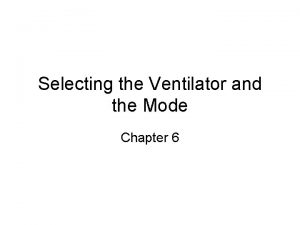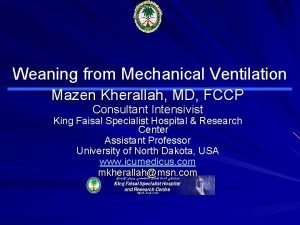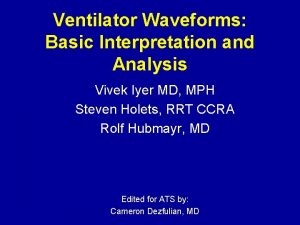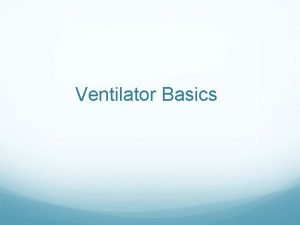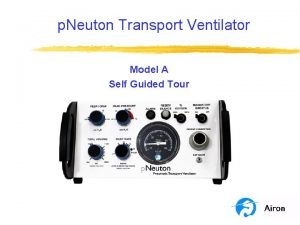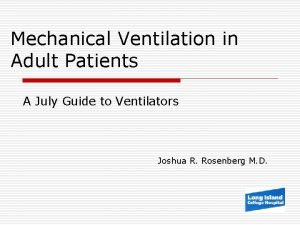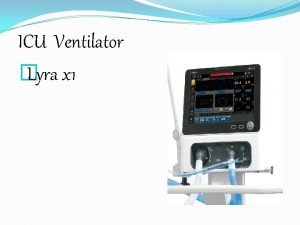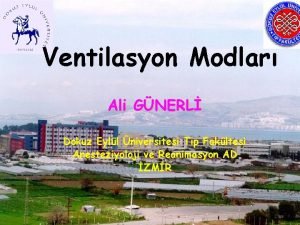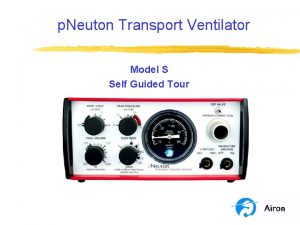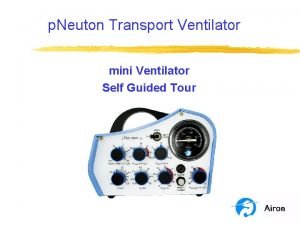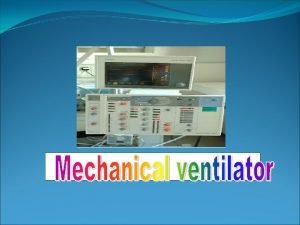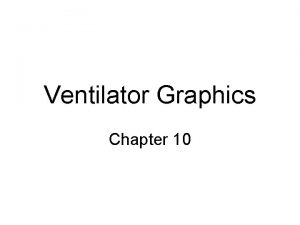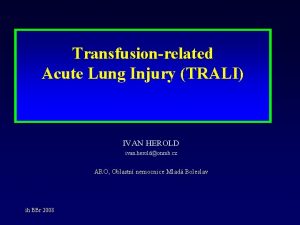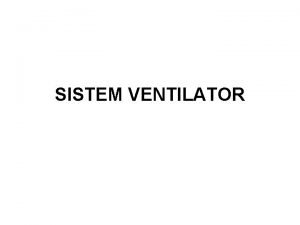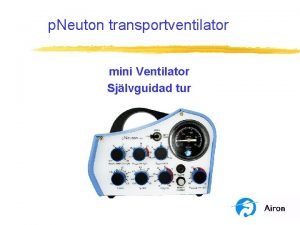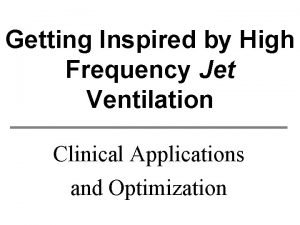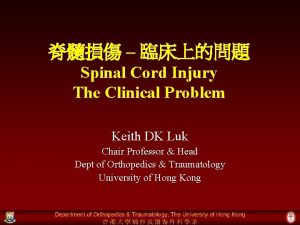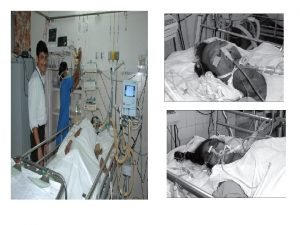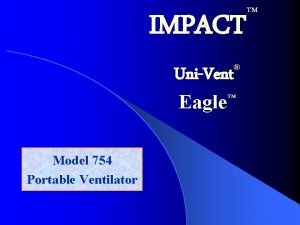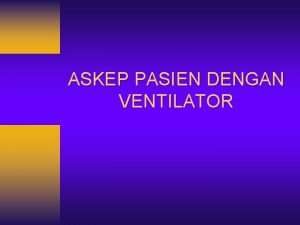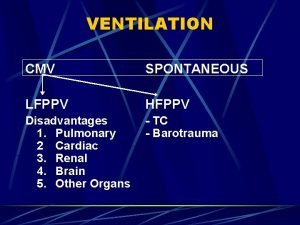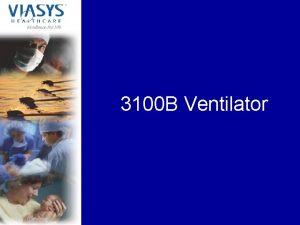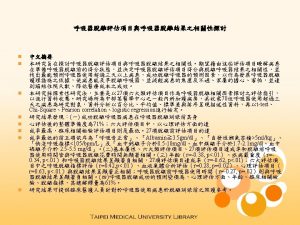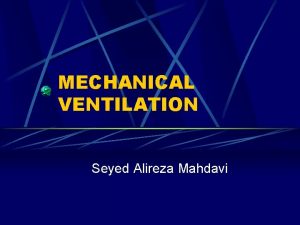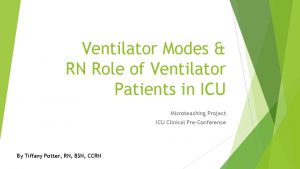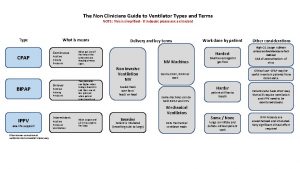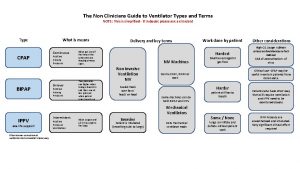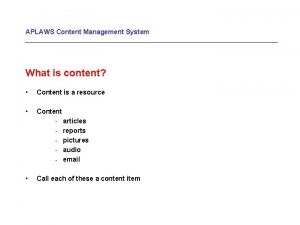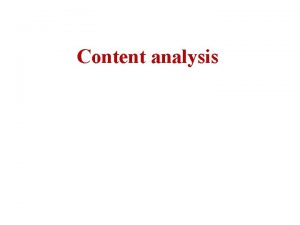Ventilator CONTENT What is a ventilator Types of























- Slides: 23

Ventilator

CONTENT… • What is a ventilator? • Types of ventilators • Modes of ventilators • Types of support • Methods of ventilatory support • Indications of ventilators

What is a ventilator? ? ? • A ventilator is a machine that supports breathing • These machines mainly are used in hospitals • Ventilators ▫ ▫ Get oxygen into the lungs Remove carbon dioxide from the body Help people breathe easier Breathe for people who have lost all ability to breathe on their own


Types of ventilators… • Negative pressure • Positive pressure

Negative Pressure Ventilators • Applies negative pressure around the chest wall. This causes intra airway pressure to become negative. Thus drawing air into the lungs through the patients nose and mouth • No artificial airway is necessary – patient must be able to control and protect own airway • Indication ▫ Selected patient with neuromuscular problems ▫ Adjunct to weaning from PEEP(Positive end expiratory pressure) • Negative pressure ventilators are simply to use and do not require intubation of the airway

Positive Pressure Ventilators • Positive pressure ventilators inflate the lungs by exerting positive pressure on the airway, forcing the alveoli to expand during inspiration • Expiration occurs passively, endotracheal intubation or trachestomy is necessary in most cases • These ventilators are widely used in the hospital setting • There are Three types of positive pressure ventilators ▫ Pressure cycled ▫ Time cycled ▫ Volume cycled


Modes of ventilators… • Time cycled ventilators • Volume cycled ventilators • Pressure cycled ventilators • High Frequency Ventilators

Time cycled ventilator • Time delivery of gas flow; tidal volume = flow rate x inspiration time • Delivers relatively constant Tidal Volume • Allows precise control of gas delivery • Types: IMV-Bird, Foregger 210, Emerson

Volume Cycled Ventilator • Inspiratory gas flow terminated after preselected volume delivery • Pressure in circuit determined by tidal volume and Compliance • Delivered Tidal volume changes with changes in Compliance • Types: Bennett, Ohio 560, Bourns Bear 1, Monaghan, Siemons Servo

Pressure cycled ventilators • Gas flow continues until preset pressure develops • Tidal volume = flow rate x time until pressure is reached • Variable volume if circuit pressure varies (change in compliance) • Types: bird mark, bennett PR

High Frequency Ventilators 5 types • High frequency positive pressure ventilation • Jet ventilation • Flow interruption • Oscillation • Percussive ventilation

Types of support… • Control mode • Support mode

Control mode • In control mode, the ventilator delivers the preset tidal volume once it is triggered regardless of patient effort • If the patient is apneic or possesses limited respiratory drive, control mode can ensure delivery of appropriate minute ventilation

Support mode • In support mode, the ventilator provides inspiratory assistance through the use of an assist pressure • The ventilator detects inspiration by the patient and supplies an assist pressure during inspiration • It terminates the assist pressure upon detecting onset of the expiratory phase • Support mode requires an adequate respiratory drive • The amount of assist pressure can be dialed in

Methods of Ventilatory Support… • Continuous mandatory ventilation • Assist-control ventilation • Intermittent mandatory ventilation • Synchronous intermittent mandatory ventilation • Pressure support ventilation • Noninvasive ventilation • Continuous positive airway pressure - CPAP

Continuous mandatory ventilation • Breaths are delivered at preset intervals, regardless of patient effort • This mode is used most often in the paralyzed or apneic patient Assist-control ventilation • The ventilator delivers preset breaths in coordination with the respiratory effort of the patient

Intermittent mandatory ventilation • With intermittent mandatory ventilation (IMV), breaths are delivered at a preset interval, and spontaneous breathing is allowed between ventilator-administered breaths Synchronous intermittent mandatory ventilation • The ventilator delivers preset breaths in coordination with the respiratory effort of the patient

Pressure support ventilation • For the spontaneously breathing patient, pressure support ventilation (PSV) has been advocated to limit barotrauma and to decrease the work of breathing Noninvasive ventilation • The application of mechanical ventilatory support through a mask in place of endotracheal intubation is becoming increasingly accepted and used in the emergency department

Continuous positive airway pressure - CPAP ▫ Improves pao 2 by stabilizing the airway and allowing alveolar recruitment. CO 2 retention may result from excessive CPAP ▫ Most commonly, nasal CPAP prongs (also mask, nasopharyngeal, endotracheal) used to respiratory assistance in mild rds(respiratory distress syndrome), or weaning from mechanical ventilation ▫ Maintains upper airway patency, so useful in apnea of infancy ▫ Gastric distension may occur; place OG tube for decompression ▫ 2 -6 cm H 20 commonly used.

Indications of ventilators … • Hypercapnic respiratory failure • Hypoxemic respiratory failure • Correction of life-threatening acidemia in the setting of salicylate intoxication • Intentional hyperventilation in the setting of major head injury with elevated intracranial pressure • Suspicion of clinical brain herniation from any cause • Patient in critical condition with cyclic antidepressant toxicity

T A H K N O Y ! ! ! U
 Mode of ventilation
Mode of ventilation Carrier content vs real content
Carrier content vs real content Dynamic content vs static content
Dynamic content vs static content Mazen kherallah
Mazen kherallah Ventilator waveform analysis
Ventilator waveform analysis Normal peak pressure
Normal peak pressure P neuton ventilator
P neuton ventilator Vc+ vs prvc
Vc+ vs prvc Lyra ventilator
Lyra ventilator Mekanik ventilatör modları
Mekanik ventilatör modları P neuton ventilator
P neuton ventilator P neuton ventilator
P neuton ventilator Vent modes
Vent modes Ventilator graphics
Ventilator graphics Plicni ventilator manufacturer
Plicni ventilator manufacturer Fungsi ventilator pada radiator
Fungsi ventilator pada radiator Mini ventilator
Mini ventilator Mean airway pressure formula
Mean airway pressure formula Servo pressure on jet ventilator
Servo pressure on jet ventilator Spinal cord injury protocol
Spinal cord injury protocol ütube
ütube Uni vent 754 ventilator
Uni vent 754 ventilator Setting ventilator
Setting ventilator Pcmv ventilator
Pcmv ventilator
